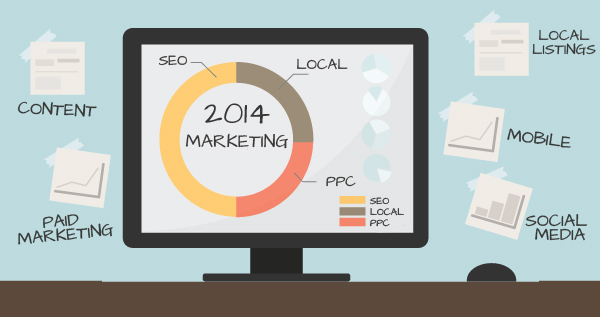
Don’t look now, but 2014 is here. What’s your strategy for making the most of it? Without a strategy, you’ll be spinning your wheels and missing out on marketing trends that could boost your business.
The best way to build a strategy is to review what worked and what didn’t. Use reliable, consistent data—like the metrics you get from Google Analytics—to identify where you were successful in 2013 and prioritize your strategy for the coming year. Start by focusing on these five key areas.
1. Is Your Website Mobile Friendly?
Monitoring mobile use of your website has never been more important. Last year, smartphone and tablet owners used their mobile devices to make more than $25 billion in online purchases, a phenomenal 80 percent increase over the prior year.
Have you seen a similar uptick in the number of mobile visitors to your site? And do visitors stick around? If you answered no to either question, conduct an audit to see where you’re weakest. And if your website isn’t mobile or tablet friendly, drop this blog and call us right now. This is an all-out emergency.
Really. Your site should function well and feature prominent calls to action no matter what device is being used—from smartphone to mini tablet to any other device developed and introduced in the span of time it took you to read this sentence. Your site needs to be responsive and keep up with the new technology your users are adopting.
2. What Was Your Content Marketing Strategy in 2013?
Did you follow a well-timed strategy for keeping your customers engaged with useful, relevant material? Or did you sporadically shoot from the hip with something half-baked and hurried, presuming each individual piece of content could succeed on its own?
Content generation is one of the hardest things to do consistently and do well, but it’s one of the more important elements of a successful website. Do you have a blog or e-newsletter? Who’s writing it and what’s in it? And how are you measuring its impact? Plan your 2014 content to drive:
- More traffic
- New subscribers
- More time on site
- More clicks throughout your e-newsletter
- Likes, links, shares and tweets on social media
Lay out an editorial calendar; some folks suggest three months ahead, some six. The point is, you need to have a plan or you’re probably not going to be consistent or thoughtful with your content.
3. Do You Have a Social Media Strategy?
Like content, social media is another area where continual activity is key to keeping your website and business robust. Activity on Facebook, Twitter, Google +, LinkedIn, Pinterest and others generates traffic on your site. And like content, social media requires a lot of time and effort. So ask yourself:
- Is your current audience really your target market? Make sure you’re talking to the right people.
- Are you using all your social media channels optimally? Again, lay out a calendar and be specific about what channels you’ll use.
- Are you following others on social media? It’s called a network for a reason.
- Was it worth it? Did your social media efforts do what you needed: drive customers to your site and move them along to conversion? You’ll know if you review your Google Analytics regularly to track:
- New followers and likes
- Posts, blogs and mentions
- Shares and retweets
- Leads generated
- Clicks on ads
(Hint: All of these numbers should be going up. If they’re not, rework your online marketing strategy.)
4. Can Your Customers Find You Easily?
Few things are more maddening than hard-to-find business listings and incorrect contact information. Have you claimed and optimized all your listings so they’re highly visible, accurate and well presented? Check your listings in local business directories such as:
- Google maps
- Bing maps
- Superpages
- Yelp
With the advent of Universal Analytics, it’s even more critical that your local business listings are correct. UA gives you customer data across platforms and devices, so you can follow the chain between online activity to offline data sources (like call center or point-of-sale systems including loyalty cards and coupons). If your local listings aren’t correct, they’re broken links in the conversion chain. Broken links are lost customers.
Review your listings and check into services like Universal Business Listing, Yext, or Localeze to help manage them.
5. How Effective Were Your Paid Marketing Efforts?
You know how much you’re paying for online marketing and you’re monitoring your ROI carefully, right? Right?
If you don’t know the answer to these questions, you’re wasting money:
- How effective was each email marketing campaign?
- Which ads generated the most traffic on your website?
- Which channels resulted in the most conversions?
This is where your attribution model will come in very handy. Knowing what emails and avenues led to the conversions and sales—and which ones led to bounces and spam reports—will help you map out a more efficient strategy for 2014.
This is also where retargeting will come in handy. Retargeting uses a simple web code to repeatedly serve your online ads to customers after they’ve bounced off your site, giving you more bang for each ad buck. Considering only 2% of web users convert on the first visit, you need an effective way to hang on longer—ultimately, until a sale is completed. Retargeting does that for you.
Now is your chance to make 2014 memorable and measurable. Set up your plans and continually monitor your progress so by this time next year, you’ll already know the answers to these strategy questions.
Let Marketing Torque work with you to plan the best year yet. Contact us today.


